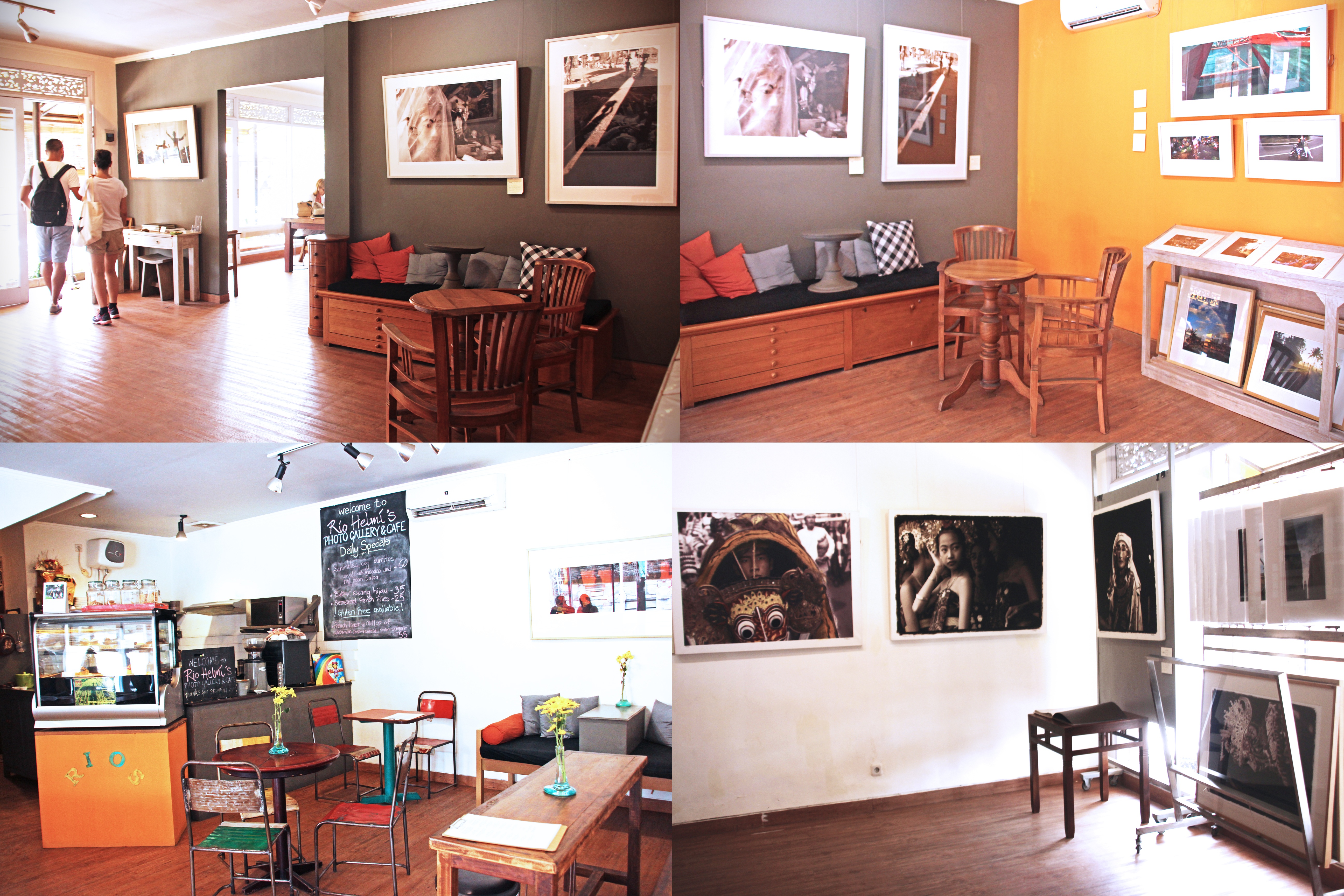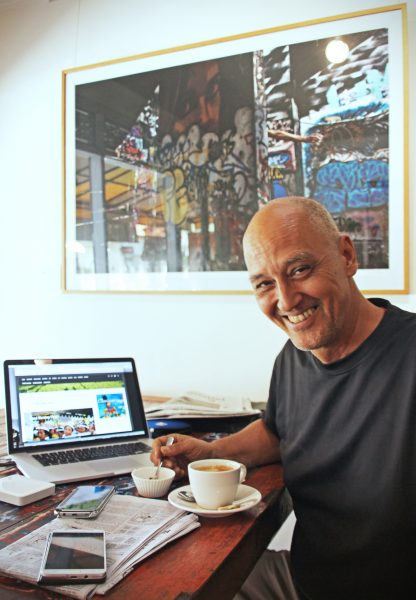Best known for his large format photo books Memories of the Sacred (2011) and River of Gems (1991, with Lorne Blair), Bali-based photographer Rio Helmi has witnessed and captured Indonesia’s changing spiritual landscapes over many decades. Grace Susetyo visits Rio in his gallery in Ubud for a conversation on Indonesian spirituality from a photographer’s perspective.
Looking at Indonesia’s spiritual landscapes through the frames of Rio Helmi’s photography is like feeling the heartbeat of a divine encounter. Flicking through Memories of the Sacred, I could almost hear the rhythm of the Balinese gamelan behind the Legong dancer and feel the weight of the avalanche of bodies in trance in a purification ritual.
Some of these photos date back to the 1980s and 1990s — a sobering realisation of the fleeting spiritual landscapes of Indonesia’s past. While many Indonesians believe that spiritual heritage transcends lifetimes, its forms never stay the same. Rio’s photography captures frozen frames of Indonesia’s spiritual history as it was at a given time.
Over time, Rio’s career has developed into a lifetime mediation of Indonesia’s ever-evolving spiritual identities. The decades of travels and human encounters behind Rio’s photography reveal diverse perspectives of the Indonesian identity through many spiritual lenses.

“There has been an Indonesian identity crisis since the Dutch colonial era,” said Rio, elaborating the modern Indonesian identity as encompassing hundreds of pre-colonial cultures any given Indonesian may identify with.
While unity among neighbouring petty kingdoms is nothing new to pre-colonial Indonesia, never before has there been a need to unite so many cultures spread among such faraway places into a single nation.
If spirituality plays an important role in any given Indonesian’s identity, it is important that the new state guarantees the right of all citizens to embrace their spiritual identities. This is why founding father Sukarno resisted the pressure to adopt an Islamic ideology and promoted a secular Indonesia founded on Pancasila.
“Sukarno had a special interest in preserving Bali’s Hindu heritage,” Rio said. Hinduism makes Bali different from other parts of non-Muslim Indonesia, which typically identify as Christian.
That said, Christianity in parts of Indonesia continues to co-exist alongside pre-colonial faiths such as Marapu in Sumba, Halaika in Timor and Aluk Todolo in Toraja. “But to acknowledge all (of Indonesia’s myriad of spiritual heritages) would be too tall an order. As Christianity gained stronger following in parts of Indonesia, indigenous faiths like Marapu got swept under the carpet. It became easier to just make people identify as Christian.”
In the 1980s, Marapu was barely known outside Sumba. Rio’s memories of East Sumba then consisted of vast savannahs where the locals raised horses. Horses were once a central element of Sumbanese culture, as they were essential to performing Marapu rituals such as the pasola – a harvest season battle between rivalling clans, where horseriding fighters hurled metal spears at each other, and shed blood was considered nourishment for the life-giving earth.
Back then, it was almost impossible to imagine Sumba without horses. “But today, ask a twentysomething Sumbanese if they’ve ridden a horse, and many would tell you they’re afraid of horses. Within one generation, an important cultural practice disappears,” Rio recalled his recent trips back to Eastern Sumba.
Rio added that traditional houses are also disappearing from Eastern Sumba. The one he did find after some extensive travels in Eastern Sumba was rehabilitated and modified for tourism purposes.
“Sure, it has the shape of a traditional house – somewhat – but it has a tin roof! It’s all symbolic, but it’s not real,” said Rio. He explained that a traditional house should reserve the top level for sacred items and the ancestors’ spirits. As a matter of fact, the word marapu in Humba language is a word for ancestors and etymologically means ‘one who is respected, glorified, and worshipped.’ But today’s ‘traditional houses’ have rooms for tourist accommodation.
However, not all hope is lost. In recent years, a resurgence of Marapu is taking place in Sumba, including in the virtual spaces of social media. “Marapu remains an essential part of the Sumbanese identity,” said Rio, adding that indigenous faiths serve an important role Abrahamic religions (Christianity, Islam) cannot replace: the intimate cultural reference that bonds Indonesians to the natural world of their ancestral homelands.
Indonesian Islam has mostly been moderate and syncretic, allowing pre-Islamic cultural practices to continue. In Java, for instance, wayang kulit – a shadow puppet show learned from Indian Hindus – played an important role in the spread of Islam.
Compared to the Nusantara brand of moderate Islam most Indonesians know, the Wahhabi brand of hard-line Islam is new to Indonesia.
“Since Abrahamic religions lack cultural references Indonesians can easily identify with in relation to their immediate natural world, it may seem righteous for some people to draw cultural references from the deserts of the Middle East instead,” said Rio. Consequently, religious teachings can sometimes be taken out of context when it was intended for a particular cultural context but enforced upon another.
This phenomenon is not unique to Abrahamic religions. According to Rio – who has been living in Bali since 1978 – the information age has motivated some Balinese to learn Indian Hinduism in order to “return to their pure Hindu roots.”
Yet the Balinese religion – which worships Sang Hyang Widi Wasa as the one supreme deity and incorporates ancient indigenous spiritual practices such as the veneration of ancestors and nature – has mostly developed independently from Indian Hinduism. Rio said he learned that at one point, the Balinese even debated whether to pass their religion as Hinduism or Buddhism, since Indonesia would not legally recognise it as ‘Agama Tirta Bali.’
“Even in India, the term ‘Hindu’ was invented to collectively refer to the diverse belief systems present in the Indian subcontinent,” said Rio, whose photography works have covered many parts of Asia with predominantly Dharmic (Hindu/Buddhist) spiritual heritage, such as Ladakh, Thailand, Myanmar and Mongolia.
Rio observed that cultural revival seems to be an indication of today’s generation’s self-consciousness with hints of desperation to prove their cultural existence and identities.
“There was a time when culture was just the way people lived,” said Rio, who was born in 1954 in Switzerland to an Indonesian diplomat father and a Turkish mother. He added that he does not mean to discredit the efforts of cultural activists who recognise that this is no time to take cultural survival for granted. “But that a culture needs to be ‘revived,’ is a telling symptom of uneasiness in this generation’s sense of identity.”
Rio Helmi Gallery & Café
Jalan Suweta No 6B
Ubud, Bali
+62 361 978773/4
[email protected]
www.riohelmi.com




